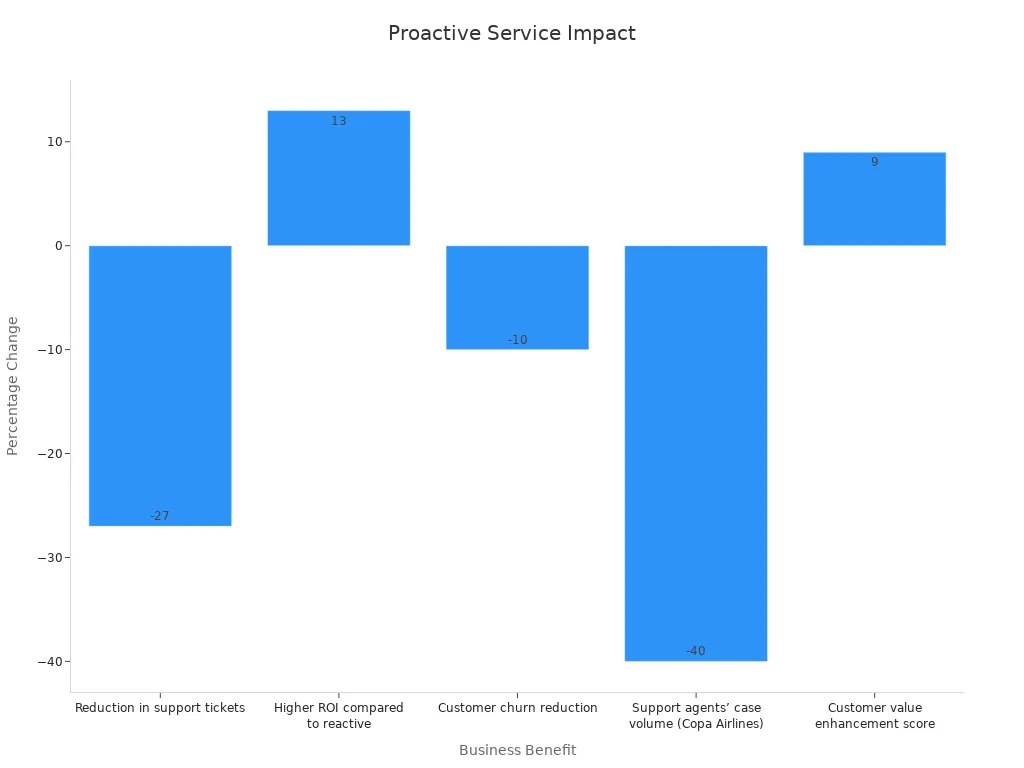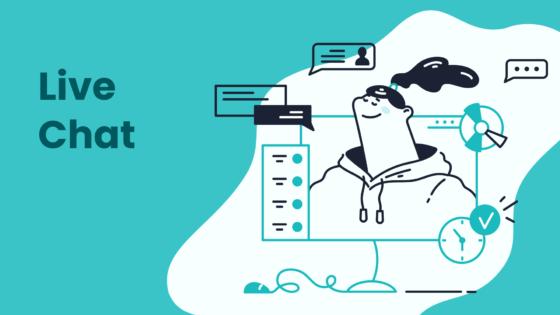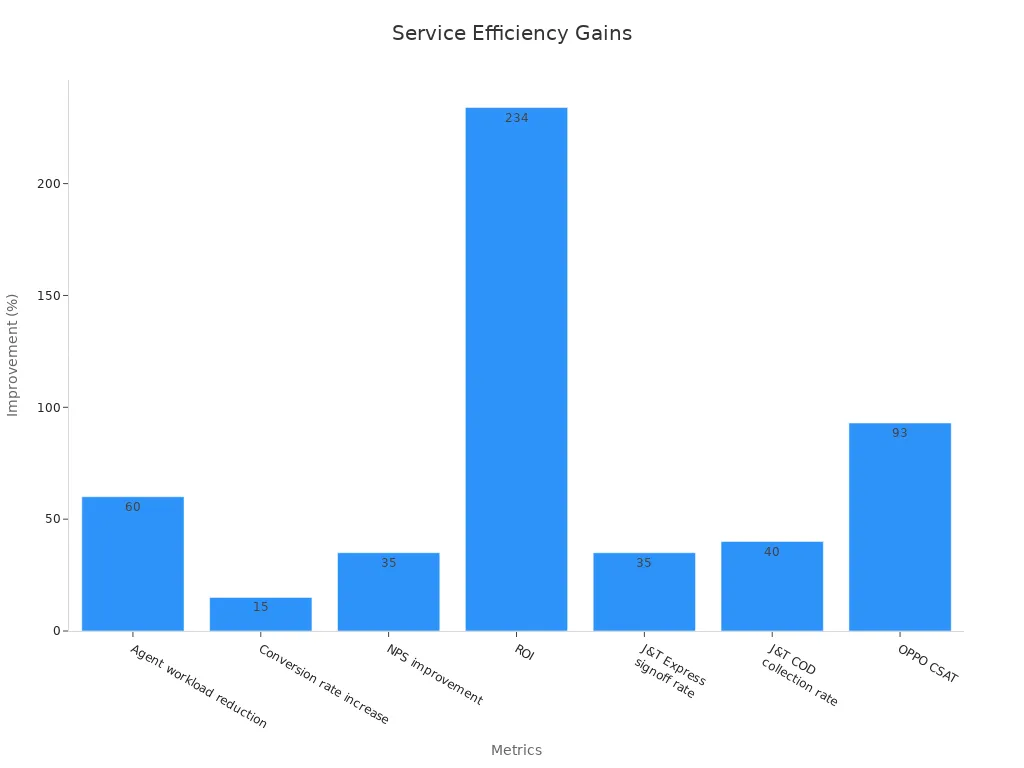A Complete Guide to Proactive Customer Service Best Practices

Proactive customer service means you reach out to customers before problems grow. This approach helps you improve customer experience and build loyalty. Companies that use proactive customer service see big results. For example, 88% of customers are likely to buy again after a good customer service experience. The table below shows how important this is for your business:
| Statistic Description | Numerical Value | Business Impact |
|---|---|---|
| Customers likely to repurchase after good service | 88% | Shows customer retention impact |
| Customers leaving brand after one bad experience | 32% | Emphasizes need for proactive issue resolution |
| US companies' annual loss due to poor customer service | $75 billion | Demonstrates huge financial risk of poor service |
Sobot leads in this area by combining innovation and customer-centricity with Sobot AI, helping you deliver excellent service before issues arise. You can see proactive customer service examples across many industries, showing how early action keeps customers happy and loyal.
Proactive Customer Service Defined
Proactive customer service means you take action before your customers face problems. You do not wait for someone to complain or ask for help. Instead, you look for signs that a customer might need support and reach out first. Industry research shows that this approach helps you build trust and loyalty. For example, 87% of US consumers say they prefer companies that engage proactively. When you use proactive customer service, you show that you care about your customers’ needs and want to make their experience better. This strategy covers the whole customer journey, from the first contact to after-sales support. Companies like Sobot use advanced tools, such as AI and analytics, to predict issues and offer solutions before customers even notice a problem. This forward-thinking approach saves time and reduces frustration for everyone involved.
Key Features
Proactive customer service has several important features that set it apart:
- You anticipate customer needs and solve problems before they grow.
- You provide personalized and timely support using data and AI tools.
- You reduce the number of support tickets by fixing issues early.
- You use predictive analytics to manage resources better.
- You build stronger relationships and increase customer loyalty.
- You use tools like chatbots, CRM systems, and automation to make service faster and more accurate.
These features help you improve customer interactions and make your service stand out. Sobot’s omnichannel solutions, for example, let you connect with customers on their favorite channels and respond quickly.
Proactive vs. Reactive
You might wonder how proactive customer service differs from reactive service. Here is a simple comparison:
| Approach | When You Act | Customer Experience | Example |
|---|---|---|---|
| Proactive | Before issues arise | Saves time, builds trust | Notifying about delays early |
| Reactive | After issues happen | Can cause frustration | Responding to complaints only |
With proactive customer service, you reach out first and prevent problems. In reactive service, you wait for customers to contact you. Proactive customer service leads to better customer interactions and higher satisfaction. Companies that use this approach, like Sobot, often see fewer complaints and more loyal customers.
Why Proactive Customer Service Matters
Impact on Customer Experience
You want your customers to feel valued and understood. Proactive customer service helps you achieve this goal. When you reach out before problems arise, you show customers that you care about their needs. This approach leads to higher customer satisfaction and stronger customer loyalty. Studies show that customers respond positively to proactive engagement. For example, research by Leyer et al. (2017) found that people appreciate when companies anticipate their needs and act early. Rau et al. (2020) also discovered that different proactive features can boost customer satisfaction scores.
You can use several tools to improve the customer service experience:
- Personalized messages based on customer data
- Timely notifications about order status or potential issues
- Omnichannel support, so customers can reach you on their favorite platforms
Gartner predicts that by 2025, 40% of customer service organizations will use proactive strategies to solve problems before they grow. Companies like Sobot use AI and analytics to predict what customers need and offer solutions quickly. This approach leads to faster issue resolution and fewer incoming inquiries. You can see higher customer satisfaction and more positive feedback when you act before customers complain.
Business Benefits
Proactive customer service does more than improve the customer experience. It brings real business results. You can see a reduction in support tickets, lower costs, and better retention rates. The benefits of proactive customer service include higher satisfaction scores and increased customer loyalty. Here is a table showing some key business outcomes:
| Business Benefit | Quantitative Data |
|---|---|
| Reduction in support tickets | 27% decrease |
| Higher ROI compared to reactive | 13% increase |
| Customer churn reduction | 10% decrease |
| Satisfaction score increase | Up to 25% boost |
| Support agents’ case volume | 40% reduction |
| Customer value enhancement score | 9% increase |
| Customer retention rate boost | 3-5% increase |

You can also measure success by tracking metrics like Net Promoter Score (NPS), customer satisfaction (CSAT), and customer effort score (CES). Sobot’s omnichannel solutions help you unify customer data and automate outreach, making it easier to deliver proactive support. When you use these tools, you build trust, reduce churn, and create a better customer service experience. Over time, you will see more loyal customers and stronger business growth.
Proactive Customer Service Best Practices

Delivering proactive customer service means you take action before problems grow. You can use several best practices to build a strong customer support strategy and improve customer satisfaction. These steps help you anticipate customer needs, offer personalized support, and create a seamless customer service experience.
Leveraging Customer Data
You can anticipate customer needs by collecting and analyzing data from every interaction. Use tools like regression analysis, cluster analysis, and sentiment analysis to spot trends in purchase history, browsing behavior, and support tickets. Predictive analytics helps you forecast what customers might need next. For example, Sobot’s unified workspace brings together data from all channels, making it easy for you to see patterns and act early. When you use these insights, you deliver proactive support and reduce the number of incoming issues.
Tip: Use customer data to segment your audience and send targeted messages. This approach leads to more personalized support and higher customer satisfaction.
Proactive Communication
Proactive communication keeps your customers informed and builds trust. You can send alerts about order updates, maintenance reminders, or potential issues before customers ask. This approach reduces churn and increases retention. For example, the Customer Health Score (CHS) uses data like purchase frequency and support interactions to spot at-risk customers. You can reach out to these customers early and solve problems before they leave.
- Send timely notifications through email, SMS, or live chat.
- Use Sobot Live Chat to automate follow-ups and keep conversations in one place.
- Maintain clear, friendly communication to encourage repeat business.
Self-Service Options
Many customers prefer to solve problems on their own. You can provide self-service options like knowledge bases, FAQs, and AI-powered chatbots. Research shows that 81% of customers try self-service before contacting support, and a good knowledge base can cut support requests by 33% in three months. Sobot’s chatbot and self-service widgets let customers find answers anytime, reducing wait times and freeing up your team for complex issues.
- Offer step-by-step guides with visuals.
- Use chatbots to handle common questions.
- Make self-service tools easy to find on your website or app.
Team Training
Your team needs the right skills to deliver proactive customer service. Train your staff with real-life scenarios, role-playing, and ongoing feedback. Set clear goals and measure success with metrics like CSAT and NPS. Sobot’s platform supports agent training by providing access to a centralized knowledge base and performance analytics.
- Define clear workflows and KPIs.
- Use video, workshops, and e-learning for diverse learning styles.
- Encourage continuous learning and regular feedback.
Note: Well-trained teams resolve issues faster and improve customer satisfaction.
Feedback Collection
Systematic customer feedback collection helps you improve your service. Gather feedback from reviews, emails, and support tickets. Analyze this data to find common pain points and make changes quickly. Companies like Gousto use real-time feedback analysis to fix problems and boost customer satisfaction. Sobot’s built-in analytics and satisfaction surveys make it easy to collect and act on feedback.
- Run regular surveys after support interactions.
- Use AI to analyze large volumes of feedback.
- Share insights with your team to drive improvements.
Technology Integration with Sobot
Integrating advanced technology streamlines your proactive customer service strategies. Sobot’s omnichannel solution combines AI, automation, and analytics to boost efficiency. You can manage all customer interactions in one place, automate routine tasks, and deliver proactive support 24/7. Sobot Live Chat supports multiple channels, offers real-time engagement, and provides built-in analytics for data-driven decisions.
| Metric / Case Study | Improvement / Result |
|---|---|
| Agent workload reduction | 60% decrease |
| Conversion rate increase | 15% increase |
| Net Promoter Score (NPS) improvement | 35% increase |
| Resolution time | Under 1 minute |
| Return on Investment (ROI) | 234% ROI |
| OPPO customer satisfaction (CSAT) | 93% achieved |

You can see how Sobot’s technology helps you deliver faster, more personalized support and achieve higher customer satisfaction. This integration makes your customer support services more efficient and scalable as your business grows.
Proactive Customer Service Examples

You can learn a lot from real-world proactive customer service examples. These stories show how companies use technology and smart strategies to improve customer interactions and satisfaction.

Sobot Live Chat in Action
Sobot Live Chat gives you a powerful way to connect with customers before problems start. You can use its omnichannel support to reach people on websites, apps, and social media. For example, when you use Sobot Live Chat, you can send proactive messages about order updates or answer questions before customers even ask. This approach leads to a 38% increase in conversion rates and a 60% reduction in agent workload. You also get built-in analytics, so you can track how well your proactive customer service works. These proactive customer service examples show how you can boost loyalty and make every customer feel valued.
Omnichannel Solutions
Omnichannel solutions help you deliver consistent proactive customer service across all channels. You can unify customer data, so every agent sees the full picture during customer interactions. This makes it easy to send personalized messages and solve problems quickly. Here are some benefits you get from using an omnichannel approach:
- Real-time support through live chat and AI chatbots
- Seamless transitions between channels for customers
- Consistent brand messaging that builds trust
- Personalized experiences based on customer data
Many proactive customer service examples highlight how omnichannel strategies improve retention and satisfaction. You can see faster resolutions and happier customers when you use these tools.
OPPO Success Story
OPPO, a global smart device brand, used Sobot’s solutions to transform its customer service. During busy shopping seasons, OPPO faced a surge in inquiries. By using Sobot’s chatbot and ticketing system, OPPO handled repetitive questions automatically and let agents focus on complex cases. This proactive customer service led to an 83% chatbot resolution rate and a 94% positive feedback rate. OPPO also saw a 57% increase in repurchase rates. These proactive customer service examples prove that early action and smart technology can drive real business success.
Tip: You can use proactive customer service examples like OPPO’s to inspire your own strategy and improve customer interactions.
Measuring Proactive Customer Service
You need to measure your proactive customer service to see if your efforts work. Tracking the right metrics helps you understand what your customers like and where you can improve. When you use clear data, you make better decisions and keep your business growing.
Key Metrics
You can use several key metrics to measure how well your proactive customer service performs. Each metric gives you a different view of your service quality and business impact.
| Metric | Purpose and Insights | Key Advantages |
|---|---|---|
| Customer Satisfaction Score (CSAT) | Shows how happy customers are after each interaction. | Tracks trends and highlights strong or weak touchpoints. |
| Net Promoter Score (NPS) | Measures how likely customers are to recommend your business. | Helps you see loyalty and advocacy potential. |
| First Contact Resolution (FCR) | Counts how many issues you solve on the first try. | Lowers repeat contacts and boosts efficiency. |
| Average Handle Time (AHT) | Tracks how long each customer interaction takes. | Helps you balance speed and quality. |
| Customer Effort Score (CES) | Shows how easy it is for customers to get help. | Points out where you can make things simpler. |
| Customer Churn Rate | Tells you how many customers leave over time. | Helps you spot and fix retention problems. |
| SLA Compliance | Checks if you meet promised service times. | Builds trust, especially in regulated industries. |
| Quality Assurance Score | Rates your service quality through regular checks. | Keeps your service consistent and highlights training needs. |
Tip: Segment your data by customer type or channel. This helps you target improvements and see which areas need more attention.
Analytics and Insights
Analytics tools help you turn raw data into clear insights. You can track trends, spot problems early, and see the real impact of your proactive customer service. For example, Sobot’s built-in analytics let you monitor metrics like CSAT, NPS, and FCR in real time. You can also use predictive analytics to find customers who might leave or need extra support.
- Use dashboards to see your key metrics at a glance.
- Set alerts for drops in customer satisfaction or rising handle times.
- Review reports regularly to guide your team’s training and workflow changes.
| KPI / Metric | Description / Role in Proactive Service Impact | Business Outcome / Example |
|---|---|---|
| Customer Retention Rate | Shows how many customers stay with you over time. | Higher retention means your proactive efforts work. |
| Response Time to Proactive Interactions | Tracks how fast you respond when you reach out first. | Faster responses lead to happier, more loyal customers. |
| Customer Lifetime Value (CLV) | Measures the total value a customer brings during their relationship. | Proactive service can increase this value by building trust. |
| Predictive Analytics | Uses data to guess what customers need next. | Lets you act before problems grow, keeping satisfaction high. |
Note: When you use Sobot’s analytics, you get a full view of your customer service performance. This helps you make smart choices and keep improving your proactive customer service.
Overcoming Challenges
Common Barriers
You may face several obstacles when you try to deliver proactive customer service. Recent industry surveys highlight these common barriers:
- Handling unexpected or complex customer questions can be tough.
- Understanding and prioritizing customer needs is not always easy.
- Managing many customers at once often leads to stress.
- Dealing with angry or upset customers can drain your team.
- High volumes of support tickets make it hard to respond quickly.
- Integrating different platforms, like CRMs and marketing tools, can be difficult.
- Support agents may feel burned out from repetitive tasks and high pressure.
Many organizations struggle to connect their systems. When you cannot unify your CRM, marketing, and service tools, you miss out on a complete view of your customers. This makes it harder to offer personalized, proactive support. Fragmented systems slow down your team and limit your ability to act before problems grow.
Note: Burnout and stress are real risks for support teams. A supportive work culture and smart tools can help reduce these issues.
Solutions and Tips
You can overcome these challenges by using the right strategies and technology. Unified workspaces and automation play a key role. Research shows that AI-powered platforms and unified collaboration tools boost both employee and customer experiences. Sobot’s unified workspace brings all your customer data and conversations together. This makes it easier for your team to see the full picture and respond quickly.
Here are some proven tips:
- Use automation to handle routine questions and tasks. This frees your agents for more complex issues.
- Train your team to manage stress and handle difficult situations.
- Integrate your CRM, marketing, and support tools for a 360-degree customer view.
- Offer self-service options, like chatbots and knowledge bases, to reduce ticket volume.
- Collect feedback and use analytics to spot trends and improve your service.
| Company | Solution Used | Result |
|---|---|---|
| Delta Airlines | Real-time support via social media | 85% faster response times, higher CSAT |
| AT&T | AI-powered chatbots | 80% inquiries resolved, 25% lower costs |
| Ritz-Carlton | Empowered staff, better training | Faster resolutions, more repeat business |
Sobot’s automation and unified workspace help you manage high volumes, reduce agent burnout, and deliver proactive customer service that keeps customers happy.
Adopting best practices in proactive customer service helps you boost customer satisfaction and build lasting customer loyalty. Tools like Sobot and Sobot Live Chat let you automate responses, track key metrics, and deliver fast support. You can see real results by focusing on measurable goals:
| Goal | Benefit | How to Achieve |
|---|---|---|
| Higher NPS | Stronger loyalty | Gather feedback, act on it |
| Faster Response | Better customer experience | Use automation, monitor times |
| Improved CSAT | Happier customers | Analyze and improve processes |
Start today by reviewing your workflows and exploring Sobot’s solutions to keep improving your customer experience.
FAQ
What is proactive customer service?
Proactive customer service means you reach out to customers before they face problems. You use data and tools to predict needs. For example, Sobot’s omnichannel solution helps you spot issues early and offer help before customers ask.
How does Sobot support proactive customer service?
Sobot gives you tools like Live Chat, AI chatbots, and a unified workspace. You can connect with customers on their favorite channels. Sobot’s analytics let you track trends and act fast, making proactive customer service easy and effective.
Why is proactive customer service important for business growth?
Proactive customer service builds trust and loyalty. Studies show 88% of customers return after a good experience. You reduce support tickets, increase satisfaction, and boost sales. Sobot’s solutions help you achieve these results by automating outreach and improving response times.
Can proactive customer service reduce agent workload?
Yes! Proactive customer service lets you automate routine tasks. Sobot’s AI chatbots handle common questions, so your team can focus on complex issues. This approach can cut agent workload by up to 60%, leading to faster resolutions and happier customers.
How do you measure the success of proactive customer service?
You track key metrics like CSAT, NPS, and first contact resolution. Sobot’s built-in analytics show you real-time results. For example, OPPO used Sobot and saw a 94% positive feedback rate. Measuring these numbers helps you improve your proactive customer service strategy.
Tip: Review your metrics often. Use the data to make your proactive customer service even better!
See Also
Comprehensive Overview Of Quality Management Systems In Call Centers
Effective Strategies For Managing Quality In Call Centers
Step-By-Step Approach To Deploy Omnichannel Contact Centers
Key Recommendations For Selecting Social Media Support Tools
